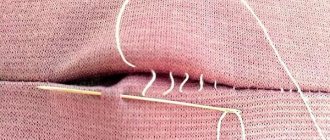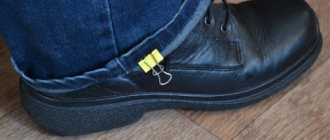Types of damage to jeans
Constant long wear and frequent washing of clothes cause the fibers of the material to wear out and begin to tear, forming holes.
- A puncture can occur from a nail or twig that gets caught.
- When falling on the floor, the ground.
- From a cut with scissors or other sharp objects.
- From a cigarette or a spark from an open fire source.
- From a sedentary lifestyle.
Reinforced seams
When you take off your shoes at the end of the day, you are surprised to see that the tights have torn in the area of your big toe. A sad sight. To avoid it, just pay a few tens of rubles more, but buy tights with a reinforced toe and high-quality seams.
There is a cheaper way: wear summer “invisible” socks, regular socks or toe socks under your tights. The thinner the socks, the better, otherwise the shoes will seem too tight. Thin underfoot socks can be purchased with a reserve. This will make sense if the problem of the thumb is particularly acute.
Where do holes appear on jeans?
Holes may appear in the most inappropriate corners of clothing. In what areas does damage in the form of holes, abrasions and seam divergence most often occur:
- On the knees
- Crotches
- On the seat
- Along the bottom edge of the trousers
- Around the pockets
Got a tiny or huge hole? No problem. It’s not at all difficult to get rid of it, the main thing is desire and imagination.
There are several tips on how to restore the beauty of your favorite jeans. After which they can be worn again and again, while forgetting about the small holes that were there.
Everyone chooses the decoration option they like, depending on the specific area of the break, the silhouette and dimensions of the repair to be repaired.
Excessive friction is the enemy of tights
Any irregularities on the toes or inside the shoes cause excessive friction. Friction can form snags that quickly turn into arrows.
Every time before putting on or taking off tights, check to see if your fingernails are broken or if there are any hangnails on your skin. Before putting on tights, it is better to once again run your hands along your legs from the very tips of your toes to the waist and make sure they are smooth. Some even lubricate their hands with cream or lotion before putting on tights. It might make sense to do this. In any case, the cream won't hurt the tights.
Types of damage and their methods of suturing
Seam rip. The seam may come apart at the sides, back, or any other area where the fabric is sewn. Sometimes a sewn-on part, such as a belt or pocket, comes undone.
- To do this, you need to carefully connect the torn edges.
- The cut edges of the parts are folded inside out, and the thread is passed into the folds of the parts.
- It is necessary to sew the halves together with a hidden seam, which helps to disguise the edges of the tears, also called invisible.
- The stitches on both sides should be equal in length.
- And they are made from the front edge, slightly pulling the thread so that the seam is stronger and of higher quality.
- After which the place of the rupture is invisible.
Scuffs
Fraying in jeans is another reason why holes are formed, which occurs while wearing clothes.
Where are they:
- In the perineum, as a result of friction against each other.
- On the seat, as a result of frequent sitting, fidgeting on the butt.
- The same wear and tear occurs from phones, notebooks, keys and other small items that are placed in your pocket.
For these types of abrasion, darning is suitable. This repair of clothing involves replacing frayed threads of material with new ones. In order for the item to be of high quality, it is necessary to select the threads according to the color, so that the thickness and texture are preferably the same.
An excellent variation could be threads from the same jeans that need to be darned. Pull it out from the folded bottom of the legs or other inconspicuous area. If you have darning or floss threads, you can use them.
At the bottom of the legs, when the pants rub against the shoes.
Jeans Bottom Repair
Trim any frayed threads or bottom edges.
- On the front side, sew up the trouser tape in a color that matches the pants.
- Wrap the ribbon inside and sew it up from the inside out.
- Iron with a hot iron.
The frayed hem can be cut off completely or down to half, turning the jeans into elegant shorts or breeches.
It matters what kind of tights you buy
Choose tight tights that do not show any skin through. If it is not possible to assess the density of the fabric visually, check the information on the packaging. First of all, you should be interested in the number of deniers - DEN. It is this indicator that is directly related to density. The higher the density, the less likely the appearance of puffs and arrows.
You don't have to buy Wolford tights (which are the same price as it would cost two people), there are plenty of smaller name brands that offer good quality tights. You can buy noname tights in 100 or even 200 denier and find that they are quite durable.
Sew up a hole in jeans (step by step)
There are many options to disguise a large or minor hole, which can be on the knees, on the pockets, on the butt, i.e. on any site.
- The most basic and easy way to remove a hole in jeans is to sew or glue an applique or terma applique onto it. This method is suitable for small holes. An applique is applied to the hole, sewn on, if it is a thermal applique, the applique is ironed well, while placing a towel on it.
- The next method is a patch, which is also an equally common option. Cut a patch larger than the tear from a piece of fabric. Apply the patch right side to the wrong side, sew it in a circle with a small seam. The seams should be on the right side of the fabric.
The patch can be:
- Denim or any woven fabric is preferable to small and medium sized holes.
- Guipure can be used to patch large holes.
- A leather patch will look better on small holes.
- Pockets from old jeans. Any pocket from unwanted pants or sundresses that is larger than the hole or stain and is suitable to cover it will do.
Filling a hole in jeans using embroidery
You can camouflage it on small torn or burnt holes by choosing a simple pattern.
- Your composition will depend on your ingenuity and invention.
- Perhaps it is a bug, spider, heart, snowflake, leaf, etc.
- And if you know or love a type of embroidery, you can make original compositions.
How to patch a hole with an angle
If your jeans are torn at an angle, you can fix them like this:
- From the inside out, it is good to iron the piece where the fabric is torn.
- Slowly tighten the edges of the tears with basting thread so that they do not unravel. Stitching occurs on the small side of the corner, then on the long side.
- Then they sew with a seam “by the needle”, and also start working with a small line.
- The finished sides of the corner are sewn with an “over the edge” seam.
- Iron through a slightly damp cloth.
It’s not scary to repair jeans by hand, without a machine; there are many interesting ideas for repairing them. Any flaws that spoil the appearance can be “furnished” and make the jeans the most fashionable and exclusive, which no one else has.
Decoration methods completely depend on the taste, skills and creative imagination of the master. It also depends on age and gender. Depending on what materials are at hand. Don't be afraid, go for it and everything will work out.
Useful tips
Even after studying all the options for how to fix jeans on the butt, many questions and difficulties may arise during the process. But it’s better not to sew up holes, but to use simple recommendations to ensure that your pants last a long time and don’t fray:
- Care of clothing must be carried out taking into account the instructions on the tag. You need to wash it separately from other items or with the same denim items. Before putting them in the washing machine, they need to be turned inside out. It is undesirable to subject clothes to frequent washing, as this leads to rapid thinning of the material. It is recommended to wash jeans on a delicate cycle, in warm water and without using bleaching agents. In this case, things will last longer, and there will be no need to sew up holes in the butt.
- You need to buy jeans that fit exactly. Very narrow or, conversely, wide ones wear out faster.
- During repairs, it is necessary to take into account the nature of the deformation. If the holes are small, it is recommended to seal them with plaster. Large holes can be masked with a patch. Secure any cracks that appear with adhesive material. The main thing is to make a decorative seam on the outside, otherwise the base will soon peel off.
- Drying is done naturally by hanging clothes on the dryer. You should not do this in a washing machine.
We recommend reading: How to clean white fur: artificial and natural
Photo examples of how to sew jeans
Freeze tights immediately after purchase
This dubious method is already the 6th in a row. We do not vouch for its reliability, so we present it only because so many people recommend it. They say that this trick allows you to extend the life of tights by 2 times.
So, take the new tights out of the packaging and wet them. Gently squeeze out excess water with your hands. Place the tights in a plastic bag and place them in the freezer overnight.
We couldn't find any scientific evidence for the effectiveness of this method of avoiding arrows, but all methods are good when it comes to the longevity of tights, right?
Photo: Maurizio Di Iorio, style: Cristiana Rivellino Santella
5 ways to avoid creases on tights
What could be worse than creases appearing on tights at the most inopportune moment?
Luckily, there is a little trick that will extend the life of your tights or stockings.
Arrow on tights: what to do?
Everything is very simple. The next time you buy a pair of tights and before you wear them, soak them under water and then place them in a plastic bag in the freezer overnight.
Repair without a needle
Tape for gluing fabric will help out if a defect appears on a beautiful trousers or shirt. Cut out a small piece of tape and apply it from the wrong side to the hole, having previously pulled its edges together.
Cover the tape with a cloth and sprinkle with water. Heat the iron and press the soleplate against the patch for 10 seconds.
Ready! Turn it inside out and admire the result.
In this way, you can repair holes in fabric burned from cigarettes, including outerwear: jackets, parkas, coats.
Patch sewing technology
Sewing on a patch is very easy. To do this, you must first prepare the necessary materials and tools. You will definitely need scissors, thread, pins and patches themselves.
Note! Before you begin repairing or decorating the product, you need to make sure that it is clean and dry. The patch must also be clean.
Manually
To manually sew a patch, you can use several methods. In each specific case, the most suitable one is selected. You can sew it with a hidden seam. It will be completely invisible. The edges of the tear need to be folded inwards, the patch secured with pins and hemmed.
If you need to make a bright accent on a piece of clothing, then you should give preference to bright threads.
Sewing a patch by hand
On a sewing machine
You can sew on the patch using a sewing machine. In this case, you will get a neat and beautiful seam. Before sewing on the patch, it must be cut from a suitable material. Turn the product inside out, put a patch on it, and secure it with running stitches made by hand. Then you will need to turn the product inside out and stitch it on a machine, then iron it. The final step will be to remove the basting stitches.
Basic recommendations
Even novice housewives can sew up a hole in clothing correctly. First, familiarize yourself with the standard repair rules:
- To prevent the seam from being visible on the fabric, the thickness of the needle must correspond to the density of the material. A needle that is too thick leaves unsightly holes. Ideally, it is better to take a bead embroidery needle - the thinnest one.
- Do not forget that the color of the threads should match the fabric as much as possible.
- Make sure there is enough thread in the needle.
- Work slowly.
- Always have a steamer with you.
- The needles must be new, smooth and free of rust.
If you can’t make a beautiful and invisible seam the first time, don’t worry and practice again. Sewing is a difficult task, but with practice it becomes enjoyable.
What to do if a puff appears on your dress
If you notice a snag on your dress, remain calm and carefully hide the loose thread. Our tips will help you do this unnoticed.
First of all, you need to determine the type of fabric and its structure. If the material is dense enough, like silk, wool or knitwear, hiding the thread will not be difficult.
It will be more difficult with light transparent and translucent materials. These types of fabrics include chiffon, chintz and eurofatin.
To hide the defect, you will need a thin needle with a voluminous eye and a steamer or iron with this function.
You can hide a hook on silk fabric or chiffon in several steps:
- Place the dress on a flat surface so that the hook is in your line of sight.
- Pierce the fabric with a needle at the snag and place the eye near the protruding thread.
- Thread the thread through the eye.
- Use a needle to pull the loop through to the wrong side.
- Carefully stretch the fabric in the problem area and treat with steam.
This option can also be used for other types of lightweight, non-stretchy materials.
Step-by-step instructions for a blind seam
Step 1
Insert the thread into the needle and tie a knot. The seam allowances should be carefully ironed inside out. The needle should be brought out from the wrong side so that the knot is hidden in the fold, and the working thread comes out exactly along the edge of the fold. Next, move to the opposite side and grab 3-6 mm of fabric with the needle, so that you get a straight stitch connecting the two parts, and the needle comes out to the front side for a new stitch.
Step 2
Move to the opposite side again, grab 3-6 mm of tissue and bring the needle to the front side. As you finish the stitch, pull the thread to tighten the pieces, but don't overdo it so you don't tighten it too much. Continue stitching until you have closed the hole.
Step 3
To complete the stitching, at the final stitch, insert the needle through the loop and tighten the knot. Repeat in the same place. A few important subtleties: firstly, your stitches should be uniform, that is, be strictly parallel to each other and spaced at the same distance. Don't put too much space between stitches or these small areas will be visible on the finished product. Photo: pinterest.com
DIY application
A lot of pleasure comes from work when you have to show your imagination. Make the applique with your own hands, then the new thing will be a joy for you!
Make an applique out of leather, because denim and leather look very original.
You can use fabric of a different color, beads, braid, multi-colored buttons . Girls can even use lace .
Floral motifs look elegant , and ethnic motifs add style. Favorite butterflies and fish will turn your pants into a cute, cozy little thing. And gold will give jeans a unique charm.
Sew a pocket onto your knee! Have no idea how to do this? Place the applique on a piece of denim, then sew it onto the hole in the form of a pocket. It will be very beautiful, and the functionality of the jeans will increase a little. One more pocket will not be superfluous.
Dear friends, knowing how to sew up jeans at the knee, you can create for yourself more than one original thing that will diversify your wardrobe.
Preparing for work
Everyone always has a needle and at least three threads of primary colors: black, white and red. In order to sew up a hole really neatly, you must learn how to sew up a frayed element on clothing aesthetically, beautifully and without visible seams. Of course, it is difficult to deal with large holes, trying to make them completely unnoticeable, but if you try, you should definitely be able to sew them up efficiently.
An important point is the fabric from which the product is made.
Before sewing, first pay attention to the size of the hole, the edges, and how frayed this area of the clothing is.











